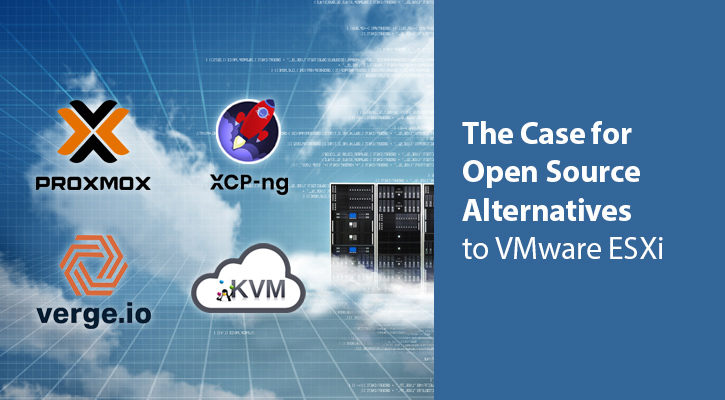The Case for Open Source Alternatives to VMware ESXi

The last two decades, virtualization has become a cornerstone for modern IT infrastructures, allowing businesses to maximize their hardware investment and improve operational efficiency. In this article, we’ll cover the top five open-source alternatives to VMware ESXi, ideal for SMBs looking for cost-effective, scalable, and reliable virtualization solutions. We’ll also touch on key considerations like vendor lock-in, integrations, and workload customization to help you make an informed decision.
Global Virtualization: A $223B Market
With the global virtualization market projected to grow to a staggering $225B by 2029, many small and medium-sized businesses (SMBs) are re-evaluating their options for creating and managing virtual environments. However, proprietary solutions like VMware ESXi have long dominated the market, but increasing licensing and support costs are leading more organizations to explore open-source alternatives.
With the virtualization market expected to surge, many decision-makers are now exploring these open-source alternatives to reduce IT costs while keeping up with ever-increasing demands for digital transformation.
Why Explore Open Source Alternatives?
As virtualization technology evolves, SMBs are faced with tough decisions regarding the cost, flexibility, and scalability of their IT infrastructure. While VMware ESXi is highly regarded for its robust feature set and performance, it comes with high licensing fees, ongoing support costs, and restrictions that limit customization for specific workloads. For SMBs operating on tight budgets, these factors can stifle growth and innovation.
Open-source virtualization platforms offer a compelling alternative. Not only are they free to use, but they also offer a high level of flexibility, community-driven support, and access to frequent updates. Moreover, open-source solutions often avoid the problem of vendor lock-in, giving businesses more control over their technology stack.
The Case for Open Source: Increasing Licensing and Support Costs
The virtualization landscape is shifting, and so are the financial realities for SMBs. One of the main drivers behind the adoption of open-source alternatives is the rising cost of proprietary solutions.
💸 Licensing Costs: Licensing fees for VMware ESXi can significantly add up, particularly as businesses scale their operations and require more virtual machines. In addition, VMware’s support packages are often expensive, leaving smaller businesses with tough choices between cost and coverage.
📜 Support Costs: On top of these costs, businesses may also find themselves locked into specific vendors. Vendor lock-in limits their ability to adapt to new technologies, integrate with other platforms, or customize their environments based on unique workload requirements. Open-source alternatives mitigate these risks, providing businesses with the flexibility to evolve their infrastructure as needed.
Key Considerations for Choosing an Open Source Virtualization Solution
Given these challenges, SMBs must proactively seek alternatives to mitigate the impact of Broadcom’s acquisition of VMware. Here are three strategies to consider.
📊 Avoid Vendor Lock-In: While the platforms we’ve highlighted offer compelling features, SMBs should keep several key considerations in mind when choosing an open-source virtualization solution.
👨💻 API & Integration Capabilities: Ensure that the platform you choose integrates well with other systems and software in your environment, such as cloud storage, networking, and backup solutions. Proxmox VE, for example, offers built-in support for many enterprise tools.
🛠️ Workload Customization: Each IT organization has unique needs, and your virtualization solution should offer flexibility in customizing for different workloads. Whether you need to run containers, virtual machines, or a mix of both, solutions like KVM and Proxmox VE offer extensive customization options.
Conclusion
As virtualization continues to shape the future of IT infrastructure, SMBs must evaluate alternatives to expensive, proprietary solutions like VMware ESXi. Open-source platforms like KVM, Proxmox, XCP-ng and Verge.io, and provide scalable, flexible, and cost-effective alternatives that allow businesses to build robust virtual environments without the financial burden of traditional licensing models. By carefully considering your organization’s needs and the key factors discussed here, you can choose the right open-source virtualization platform that offers the performance, scalability, and flexibility to grow your business.
